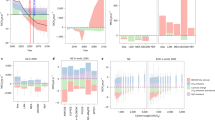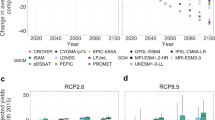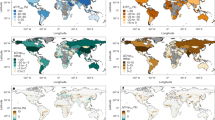Abstract
Earlier studies have noted potential adverse impacts of land-related emissions mitigation strategies on food security, particularly due to food price increases—but without distinguishing these strategies’ individual effects under different conditions. Using six global agroeconomic models, we show the extent to which three factors—non-CO2 emissions reduction, bioenergy production and afforestation—may change food security and agricultural market conditions under 2 °C climate-stabilization scenarios. Results show that afforestation (often simulated in the models by imposing carbon prices on land carbon stocks) could have a large impact on food security relative to non-CO2 emissions policies (generally implemented as emissions taxes). Respectively, these measures put an additional 41.9 million and 26.7 million people at risk of hunger in 2050 compared with the current trend scenario baseline. This highlights the need for better coordination in emissions reduction and agricultural market management policies as well as better representation of land use and associated greenhouse gas emissions in modelling.
This is a preview of subscription content, access via your institution
Access options
Access Nature and 54 other Nature Portfolio journals
Get Nature+, our best-value online-access subscription
$32.99 / 30 days
cancel any time
Subscribe to this journal
Receive 12 digital issues and online access to articles
$119.00 per year
only $9.92 per issue
Buy this article
- Purchase on SpringerLink
- Instant access to full article PDF
Prices may be subject to local taxes which are calculated during checkout





Similar content being viewed by others
Data availability
Model output data are available at https://doi.org/10.5281/zenodo.5793100. Data derived from the original scenario database, which are shown as figures but are not in the above database, are available upon reasonable request from the corresponding authors. Source data are provided with this paper.
Code availability
All code used for data analysis and creating the figures is available via Zenodo at https://zenodo.org/record/5793100#.YcB0w2jP2Uk.
Change history
30 March 2022
A Correction to this paper has been published: https://doi.org/10.1038/s43016-022-00495-x
References
Blanco, G. et al. Drivers, Trends and Mitigation (Cambridge Univ. Press, 2014).
Fuss, S. et al. Negative emissions—part 2: costs, potentials and side effects. Environ. Res. Lett. 13, 063002 (2018).
Popp, A., Lotze-Campen, H. & Bodirsky, B. Food consumption, diet shifts and associated non-CO2 greenhouse gases from agricultural production. Glob. Environ. Change 20, 451–462 (2010).
Harmsen, J. H. M. et al. Long-term marginal abatement cost curves of non-CO2 greenhouse gases. Environ. Sci. Policy 99, 136–149 (2019).
Hasegawa, T. & Matsuoka, Y. Climate change mitigation strategies in agriculture and land use in Indonesia. Mitig. Adapt. Strateg. Glob. Change 20, 409–424 (2015).
Global Mitigation of Non-CO2 Greenhouse Gases: 2010–2030 (US Environmental Protection Agency, 2013).
Hasegawa, T. et al. Risk of increased food insecurity under stringent global climate change mitigation policy. Nat. Clim. Change 8, 699–703 (2018).
Fuss, S. et al. Betting on negative emissions. Nat. Clim. Change 4, 850–853 (2014).
Gambhir, A., Butnar, I., Li, P.-H., Smith, P. & Strachan, N. A review of criticisms of integrated assessment models and proposed approaches to address these, through the lens of BECCS. Energies 12, 1747 (2019).
Gough, C. et al. Challenges to the use of BECCS as a keystone technology in pursuit of 1.5 °C. Glob. Sustain. 1, e5 (2018).
Hasegawa, T. et al. Consequence of climate mitigation on the risk of hunger. Environ. Sci. Technol. 49, 7245–7253 (2015).
Hasegawa, T. et al. Food security under high bioenergy demand toward long-term climate goals. Climatic Change 163, 1587–1601 (2020).
Fujimori, S. et al. A multi-model assessment of food security implications of climate change mitigation. Nat. Sustain. 2, 386–396 (2019).
Fujimori, S. et al. Inclusive climate change mitigation and food security policy under 1.5 °C climate goal. Environ. Res. Lett. 13, 074033 (2018).
Frank, S. et al. Agricultural non-CO2 emission reduction potential in the context of the 1.5 °C target. Nat. Clim. Change 9, 66–72 (2019).
Doelman, J. C. et al. Afforestation for climate change mitigation: potentials, risks and trade-offs. Glob. Change Biol. 26, 1576–1591 (2020).
Humpenöder, F. et al. Investigating afforestation and bioenergy CCS as climate change mitigation strategies. Environ. Res. Lett. 9, 064029 (2014).
Golub, A. A. et al. Global climate policy impacts on livestock, land use, livelihoods, and food security. Proc. Natl Acad. Sci. USA 110, 20894–20899 (2013).
Hussein, Z., Hertel, T. & Golub, A. Climate change mitigation policies and poverty in developing countries. Environ. Res. Lett. 8, 035009 (2013).
Peña-Lévano, L. M., Taheripour, F. & Tyner, W. E. Climate change interactions with agriculture, forestry sequestration, and food security. Environ. Resour. Econ. 74, 653–675 (2019).
Fujimori, S. et al. SSP3: AIM implementation of Shared Socioeconomic Pathways. Glob. Environ. Change 42, 268–283 (2017).
Thompson, W. et al. Long-term crop productivity response and its interaction with cereal markets and energy prices. Food Policy 84, 1–9 (2019).
Sands, R. D., Förster, H., Jones, C. A. & Schumacher, K. Bio-electricity and land use in the Future Agricultural Resources Model (FARM). Climatic Change 123, 719–730 (2013).
Calvin, K. et al. The SSP4: a world of deepening inequality. Glob. Environ. Change 42, 284–296 (2017).
Fricko, O. et al. The marker quantification of the Shared Socioeconomic Pathway 2: a middle-of-the-road scenario for the 21st century. Glob. Environ. Change 42, 251–267 (2017).
van Vuuren, D. P. et al. Energy, land-use and greenhouse gas emissions trajectories under a green growth paradigm. Glob. Environ. Change 42, 237–250 (2017).
Hasegawa, T., Fujimori, S., Takahashi, K. & Masui, T. Scenarios for the risk of hunger in the twenty-first century using Shared Socioeconomic Pathways. Environ. Res. Lett. 10, 014010 (2015).
Hasegawa, T., Fujimori, S., Takahashi, K., Yokohata, T. & Masui, T. Economic implications of climate change impacts on human health through undernourishment. Climatic Change 136, 189–202 (2016).
Riahi, K. et al. The Shared Socioeconomic Pathways and their energy, land use, and greenhouse gas emissions implications: an overview. Glob. Environ. Change 42, 153–168 (2017).
Stehfest, E. et al. Key determinants of global land-use projections. Nat. Commun. 10, 2166 (2019).
Hasegawa, T. et al. Extreme climate events increase risk of global food insecurity and adaptation needs. Nat. Food 2, 587–595 (2021).
Hasegawa, T., Fujimori, S., Takahashi, K. & Masui, T. Scenarios for the risk of hunger in the twenty-first century using Shared Socioeconomic Pathways. Environ. Res. Lett. 10, 014010 (2015).
von Lampe, M. et al. Why do global long-term scenarios for agriculture differ? An overview of the AgMIP Global Economic Model Intercomparison. Agric. Econ. 45, 3–20 (2014).
Harmsen, M. et al. The role of methane in future climate strategies: mitigation potentials and climate impacts. Climatic Change 163, 1409–1425 (2020).
Gernaat, D. E. H. J. et al. Understanding the contribution of non-carbon dioxide gases in deep mitigation scenarios. Glob. Environ. Change 33, 142–153 (2015).
Daioglou, V., Doelman, J. C., Wicke, B., Faaij, A. & van Vuuren, D. P. Integrated assessment of biomass supply and demand in climate change mitigation scenarios. Glob. Environ. Change 54, 88–101 (2019).
Popp, A. et al. Land-use futures in the shared socio-economic pathways. Glob. Environ. Change 42, 331–345 (2017).
Rogelj, J., Meinshausen, M., Schaeffer, M., Knutti, R. & Riahi, K. Impact of short-lived non-CO2 mitigation on carbon budgets for stabilizing global warming. Environ. Res. Lett. 10, 075001 (2015).
Grubler, A. et al. A low energy demand scenario for meeting the 1.5 °C target and sustainable development goals without negative emission technologies. Nat. Energy 3, 515–527 (2018).
van Vuuren, D. P. et al. Alternative pathways to the 1.5 °C target reduce the need for negative emission technologies. Nature Clim. Change 8, 391–397 (2018).
Wise, M. et al. Implications of limiting CO2 concentrations for land use and energy. Science 324, 1183–1186 (2009).
Calvin, K. et al. Trade-offs of different land and bioenergy policies on the path to achieving climate targets. Climatic Change 123, 691–704 (2014).
Fujimori, S., Hasegawa, T. & Oshiro, K. An assessment of the potential of using carbon tax revenue to tackle poverty. Environ. Res. Lett. 15, 114063 (2020).
Springmann, M. et al. Mitigation potential and global health impacts from emissions pricing of food commodities. Nat. Clim. Change 7, 69–74 (2017).
Stehfest, E. et al. Climate benefits of changing diet. Climatic Change 95, 83–102 (2009).
Hasegawa, T., Havlík, P., Frank, S., Palazzo, A. & Valin, H. Tackling food consumption inequality to fight hunger without pressuring the environment. Nat. Sustain. 2, 826–833 (2019).
Leclère, D. et al. Bending the curve of terrestrial biodiversity needs an integrated strategy. Nature 585, 551–556 (2020).
Fujimori, S. et al. Macroeconomic impacts of climate change driven by changes in crop yields. Sustainability 10, 3673 (2018).
Reilly, J., Hohmann, N. & Kane, S. Climate change and agricultural trade. Glob. Environ. Change 4, 24–36 (1994).
Bodirsky, B. L. et al. Reactive nitrogen requirements to feed the world in 2050 and potential to mitigate nitrogen pollution. Nat. Commun. 5, 3858 (2014).
Vitousek, P. M., Menge, D. N. L., Reed, S. C. & Cleveland, C. C. Biological nitrogen fixation: rates, patterns and ecological controls in terrestrial ecosystems. Philos. Trans. R. Soc. B 368, 20130119 (2013).
Hejazi, M. et al. Long-term global water projections using six socioeconomic scenarios in an integrated assessment modeling framework. Technol. Forecast. Soc. Change 81, 205–226 (2014).
van Vuuren, D. P. et al. RCP2.6: exploring the possibility to keep global mean temperature increase below 2 °C. Climatic Change 109, 95–116 (2011).
Fricko, O. et al. The marker quantification of the Shared Socioeconomic Pathway 2: A middle-of-the-road scenario for the 21st century. Glob. Environ. Change 42, 251 (2017).
Debeljak, M. et al. Potential of multi-objective models for risk-based mapping of the resilience characteristics of soils: demonstration at a national level. Soil Use Manag. 25, 66–77 (2009).
Bai, Z. G., Dent, D. L., Olsson, L. & Schaepman, M. E. Global Assessment of Land Degradation and Improvement: 1. Identification by Remote Sensing (ISRIC—World Soil Information, 2008).
van Zeist, W.-J. et al. Are scenario projections overly optimistic about future yield progress? Glob. Environ. Change 64, 102120 (2020).
Borgonovo, E. Sensitivity analysis with finite changes: an application to modified EOQ models. Eur. J. Oper. Res. 200, 127–138 (2010).
Borgonovo, E. A methodology for determining interactions in probabilistic safety assessment models by varying one parameter at a time. Risk Anal. 30, 385–399 (2010).
Marangoni, G. et al. Sensitivity of projected long-term CO2 emissions across the Shared Socioeconomic Pathways. Nat. Clim. Change 7, 113–117 (2017).
Fujimori, S., Hasegawa, T., Masui, T. & Takahashi, K. Land use representation in a global CGE model for long-term simulation: CET vs. logit functions. Food Sec. 6, 685–699 (2014).
Fujimori, S., Masui, T. & Matsuoka, Y. AIM/CGE [Basic] Manual (Center for Social and Environmental Systems Research, National Institute for Environmental Studies, 2012).
Woltjer, G. B. & Kuiper, M. H. The MAGNET Model: Module Description (LEI Wageningen UR, 2014).
Stehfest, E., van Vuuren, D., Bouwman, L. & Kram, T. Integrated Assessment of Global Environmental Change with IMAGE 3.0: Model Description and Policy Applications (PBL Netherlands Environmental Assessment Agency, 2014).
Lucas, P. L., van Vuuren, D. P., Olivier, J. G. J. & den Elzen, M. G. J. Long-term reduction potential of non-CO2 greenhouse gases. Environ. Sci. Policy 10, 85–103 (2007).
Havlík, P. et al. Climate change mitigation through livestock system transitions. Proc. Natl Acad. Sci. USA 111, 3709–3714 (2014).
Kindermann, G. E., Obersteiner, M., Rametsteiner, E. & McCallum, I. Predicting the deforestation-trend under different carbon-prices. Carbon Balance Manag. 1, 15 (2006).
Kyle, P. et al. GCAM 3.0 Agriculture and Land Use: Data Sources and Methods (Pacific Northwest National Laboratory, 2011).
Calvin, K. et al. GCAM v5.1: representing the linkages between energy, water, land, climate, and economic systems. Geosci. Model Dev. 12, 677–698 (2019).
Wise, M. & Calvin, K. GCAM 3.0 Agriculture and Land Use: Technical Description of Modeling Approach (PNNL, 2011).
Armington, S. P. A theory of demand for products distinguished by place of production. Staff Papers 16, 159–178 (1969).
Domínguez, I. P. et al. An Economic Assessment of GHG Mitigation Policy Options for EU Agriculture. Report No. JRC101396 (Publications Office of the European Union, 2016).
Sands, R. D., Malcolm, S. A., Suttles, S. A. & Marshall, E. Dedicated Energy Crops and Competition for Agricultural Land (US Department of Agriculture, 2017).
Lanz, B. & Rutherford, T. F. GTAPinGAMS: multiregional and small open economy models. J. Glob. Econ. Anal. 1, 1–77 (2016).
The State of Food Insecurity in the World 2012 (FAO, 2012).
Emissions Database for Global Atmospheric Research (EDGAR) Version 4.2 (Joint Research Centre, European Commission, 2012); http://edgar.jrc.ec.europa.eu
FAO Methodology for the Measurement of Food Deprivation: Updating the Minimum Dietary Energy Requirements (FAO, 2008).
Food Security Indicators (FAO, 2013).
Energy and Protein Requirements (FAO and World Health Organization, 1973).
Shared Socioeconomic Pathways (SSP) Database Version 0.9.3 (International Institute for Applied Systems Analysis, 2012); https://tntcat.iiasa.ac.at/SspDb
Acknowledgements
S. Fujimori, W.W., T.H. and K.T. are supported by the Environment Research and Technology Development Fund (JPMEERF20202002) of the Environmental Restoration and Conservation Agency of Japan. S. Fujimori, T.H. and K.T. are supported by the Sumitomo Foundation. W.W. was supported by the Japan Society for the Promotion of Science KAKENHI (grant no. JP20K20031). H.v.M., A.T. and W.-J.v.Z. received funding from the Dutch Ministry of Agriculture, Nature and Food Security through the Wageningen University Knowledge Base programme (Circular and Climate Neutral Society, KB-34-003-001 Integrated toolbox for cross-sectoral forward looking assessments and scenarios). S. Frank, P.H. and H.V. received funding from the European Union’s H2020 ENGAGE (grant no. 821471) and NAVIGATE (grant no. 821124). This research was supported by the Economic Research Service of the US Department of Agriculture.
Author information
Authors and Affiliations
Contributions
S. Fujimori and W.W. designed the research. W.W. and S. Fujimori carried out analysis of the modelling results. W.W. created figures. S. Fujimori and W.W. wrote the draft of the paper. S. Fujimori, W.W., T.H., J.D., S. Frank, J.H., P.K., R.S., W.-J.v.Z., P.H., I.P.D., A.S., E.S., A.T., H.V. and H.v.M. set up the model. W.W., T.H., J.D., S. Frank, J.H., P.K., R.S. and W.-J.v.Z. simulated the model, and all authors contributed to writing the entire manuscript.
Corresponding authors
Ethics declarations
Competing interests
The authors declare no competing interests. The findings and conclusions in this publication are those of the authors and should not be construed to represent any official USDA or US government determination or European Commission policy.
Peer review
Peer review information
Nature Food thanks Alexandre Köberle and the other, anonymous, reviewer(s) for their contribution to the peer review of this work.
Additional information
Publisher’s note Springer Nature remains neutral with regard to jurisdictional claims in published maps and institutional affiliations.
Supplementary information
Supplementary Information
Supplementary Figs. 1–26 and Tables 1–9.
Source data
Source Data Fig. 2
Source data for Fig. 2 to ensure reproducibility.
Source Data Fig. 3
Source data for Fig. 3 to ensure reproducibility.
Source Data Fig. 4
Source data for Fig. 4 to ensure reproducibility.
Source Data Fig. 5
Source data for Fig. 5 to ensure reproducibility.
Rights and permissions
About this article
Cite this article
Fujimori, S., Wu, W., Doelman, J. et al. Land-based climate change mitigation measures can affect agricultural markets and food security. Nat Food 3, 110–121 (2022). https://doi.org/10.1038/s43016-022-00464-4
Received:
Accepted:
Published:
Issue date:
DOI: https://doi.org/10.1038/s43016-022-00464-4
This article is cited by
-
Costs of transitioning the livestock sector to net-zero emissions under future climates
Nature Communications (2025)
-
Addressing critiques refines global estimates of reforestation potential for climate change mitigation
Nature Communications (2025)
-
Labour market evolution is a key determinant of global agroeconomic and environmental futures
Nature Food (2025)
-
Heterogeneous pressure on croplands from land-based strategies to meet the 1.5 °C target
Nature Climate Change (2025)
-
Enhancing the prediction accuracy of greenhouse temperatures through hybrid machine learning models: an in-depth comparative analysis of RBF, RF, and XGBoost techniques combined with SMA and MFO optimization strategies
Multiscale and Multidisciplinary Modeling, Experiments and Design (2025)



